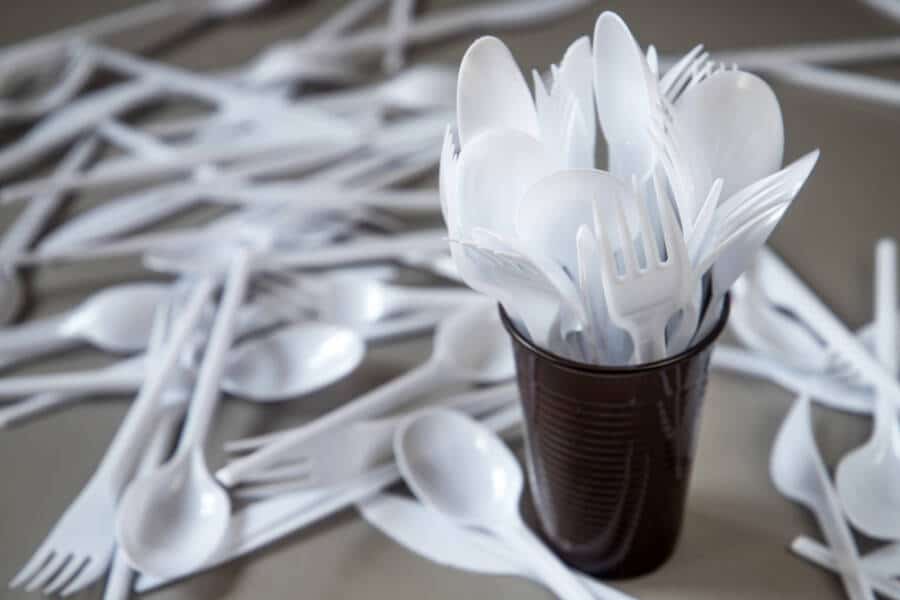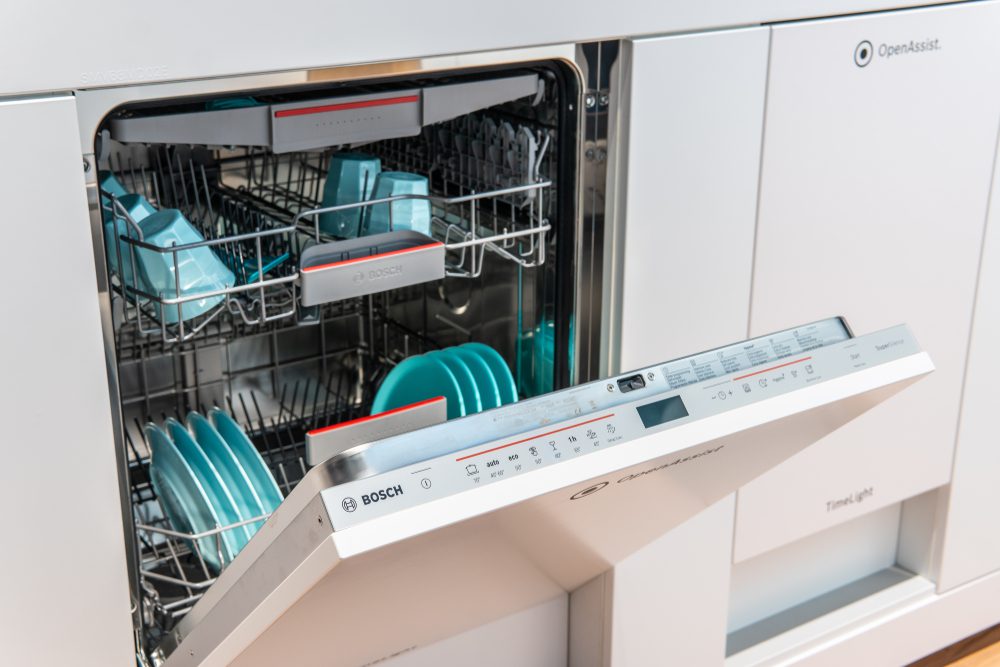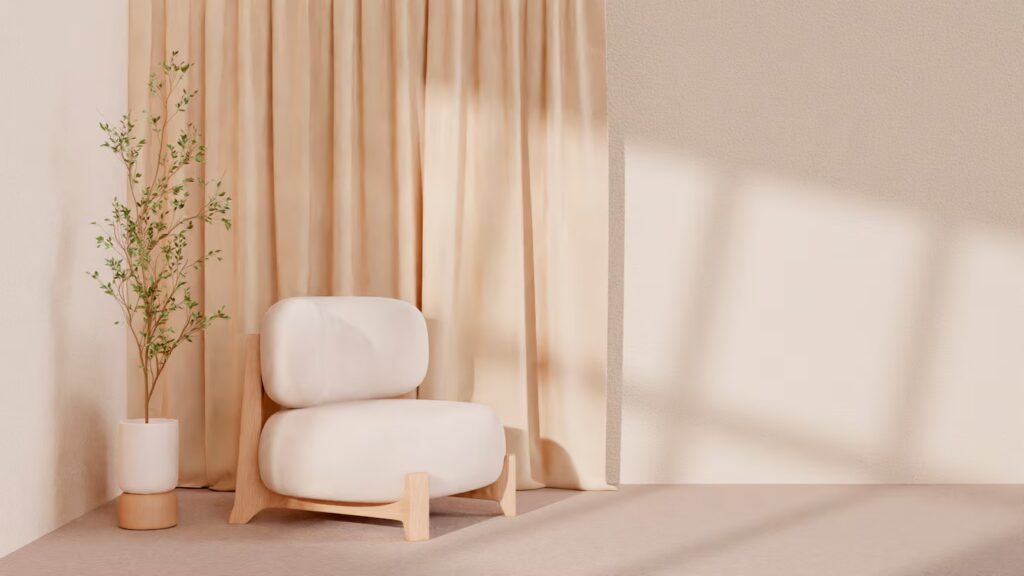Watering a rubber plant is like filling up a gas tank—it’s an essential part of keeping the motor running. But how often do you need to water your rubber plant?
If you want to keep yours healthy and thriving, understanding when and how much to water your beloved houseplant can make all the difference.
In this article, I’ll be guiding you through everything you need to know about watering your rubber plant so that you can keep it looking lush and vibrant for years to come.
Here’s How Often to Water Rubber Plant?
Water a rubber plant every 1-2 weeks. Check the top few inches of soil, and if it feels dry, water the plant until moisture is observed running out of the drainage holes. Reduce watering frequency in the winter months when plant growth slows down.
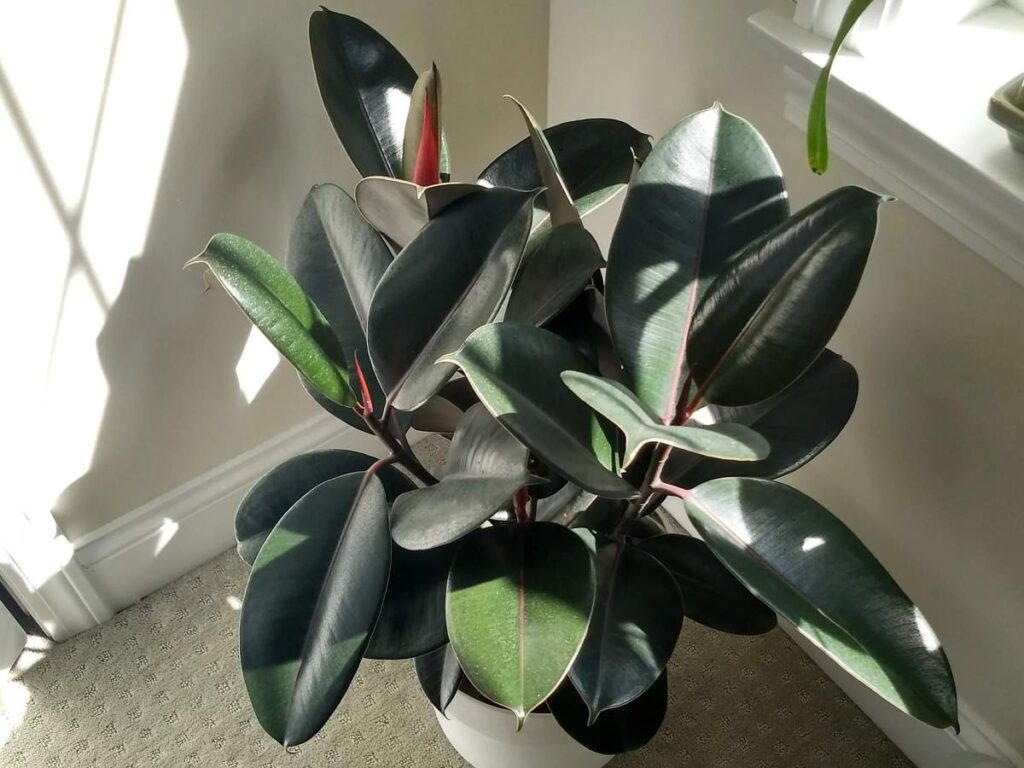
Benefits of Watering a Rubber Plant
Watering a rubber plant is like giving it the hug that it needs. It’s easy to forget that plants need regular care and attention in order to thrive, but with a little bit of water, these hardy houseplants can really come alive!
Regular watering keeps its leaves shiny and healthy, while also improving air quality by releasing oxygen into your home or office space.
Besides looking great, there are plenty of other benefits to having a well-watered rubber plant around you. The soil retains moisture for longer periods of time, which helps prevent root rot, an issue common among many types of plants.
Additionally, if you keep your rubber plant humidified, this will help protect against pests and diseases from attacking the stem or roots, making sure your beloved greenery stays strong and vibrant!
Finally, ensuring consistent hydration may even encourage growth in size as new leaves appear more often when they have access to sufficient water.
What Happens when A Rubber Plant Doesn’t Get Enough Water?
Not getting enough water for your rubber plant can be detrimental to its health and may even lead to its death.
It’s important to keep an eye on how often you’re watering your rubber plant and make sure it gets enough hydration. Too little water will cause the leaves to shrivel up and eventually fall off, while too much water makes them yellow or brown from root rot. The soil should feel slightly damp when touched, but not soggy.
If needed, check the moisture level by sticking your finger into the top two inches of soil. Depending on the environment, light levels, and temperature, most rubber plants need to be watered once every 7–10 days.
How to Tell if Your Rubber Plant Needs Water
First off, one sign that your rubber plant is in need of water is if its leaves start wilting or drooping. This usually happens because the soil has become too dry, so make sure to check the moisture level before reaching for the watering can.
Another indication that your rubber plant might need more water is if its leaves are starting to look yellowish-brown or crispy around their edges.
Additionally, if you notice any discoloration on the stem or trunk of the plant, this could also indicate an issue with dehydration.
So there you have it: by staying observant and noting any signs of distress from your beloved rubber plant, you’ll soon get into a routine that works best for both of you!
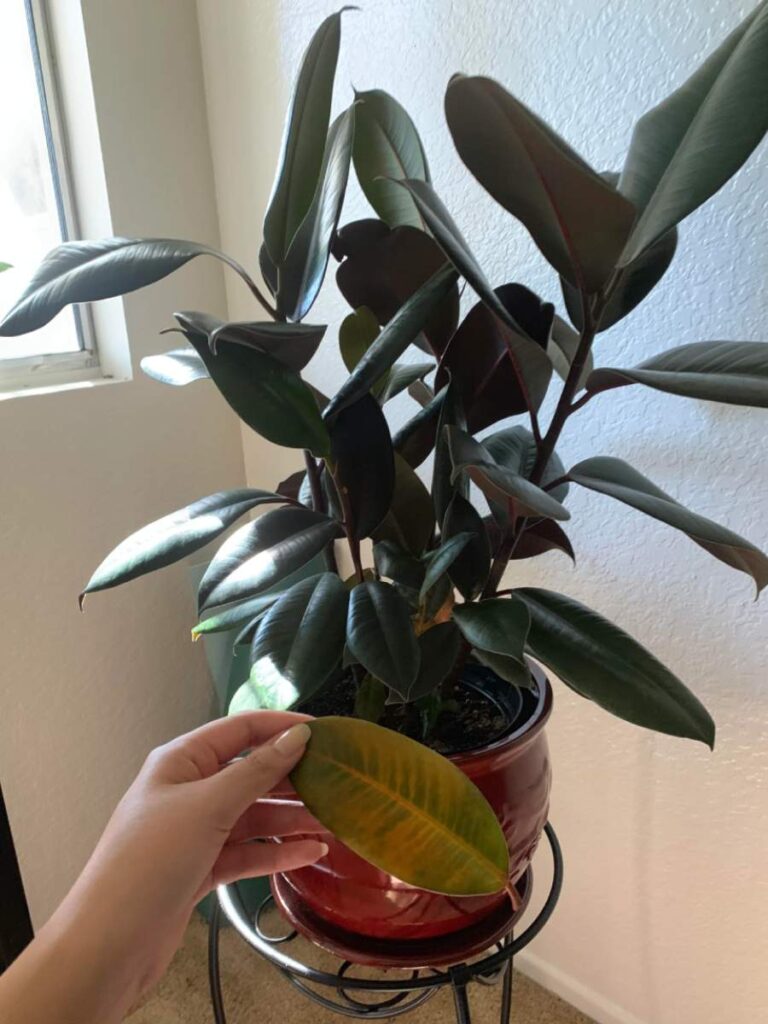
The Right Soil for A Rubber Plant
When it comes to rubber plants, soil is everything. Properly caring for them requires an understanding of what type of soil they need and how often you should water that soil. I recently had the opportunity to care for a rubber plant in my home, so I learned firsthand how important this knowledge can be.
The first step in making sure your rubber plant thrives is selecting the right type of soil. A well-draining mix with plenty of organic matter like peat moss or coco coir will help keep your plant healthy because it won’t become overly soggy when watered. To ensure proper drainage, consider adding perlite or pumice as well.
While these might not be traditional ingredients for container gardens, they are essential for keeping your rubber plant’s roots from becoming too damp and potentially rotting away.
Once you have the right soil mixture for your rubber plant, the next step is knowing how much moisture it needs to survive and thrive. Rubber plants prefer dryer climates — try withholding water until the top inch or two of soil begins to feel dry before watering again — but overwatering can still occur if their roots sit in wet conditions for too long.
Be sure to check regularly that there isn’t excess standing water at the bottom of its pot; otherwise, repotting may be necessary to prevent root rot.
Tips for Watering a Rubber Plant
Watering a rubber plant on the right schedule is essential for keeping it healthy and happy. When you start to take care of your rubber plant, it’s important to figure out how often it needs watered.
To determine this, stick your finger into the soil about an inch or two deep—if it feels moist, then you don’t need to water yet. If not, then go ahead and give your plant a good drink!
Generally speaking, most rubber plants prefer to be kept moderately moist, so aim for watering them once every 7–10 days in spring and summer and about once every 3 weeks during fall and winter.
You can also mist the leaves of your rubber plant occasionally as well – just make sure that the air around it isn’t too dry, otherwise its leaves may become crispy.
No matter what time of year it is, though, always check the moisture level before you decide whether or not to water. Too much water can cause root rot, while too little will leave your plant feeling parched. Keep an eye on things throughout each season and adjust accordingly; with some patience and practice, you’ll soon get a feel for when your rubber plant needs more water!
How Much Water Should You Give a Rubber Plant?
The truth is, there’s no one-size-fits-all answer when it comes to watering a rubber plant. It depends on factors such as its size, location, soil type, and environment.
Generally speaking, though, you’ll want to keep the soil moist but not soggy—think damp rather than drenched. Water your rubber plant thoroughly once or twice a week during summertime and then decrease the frequency for the winter months.
If you’re ever unsure about whether it needs more water, just wait until the top inch of soil has dried out before giving it another drink. Taking these simple steps will help ensure your rubber plant remains happy and healthy for years to come!
Factors that Impact how Often You Need to Water a Rubber Plant
As the age-old saying goes, “too much of a good thing can be bad,” and this is certainly true when it comes to watering your rubber plant. When I was first starting out with house plants, I thought I could just pour water on my rubber plant every day without a second thought—boy, was that a mistake! Nowadays, understanding how often you need to water your rubber plant will depend on several factors.
Firstly, you’ll want to consider the size of your particular rubber tree. If it’s relatively small compared to other trees in its species, then chances are you won’t need as frequent watering sessions. On the flip side, if your rubber tree has grown large since you got it—congratulations, by the way—then naturally more water is needed so those big leaves don’t wilt or turn brown.
Secondly, take into account where exactly the pot is located in relation to windows and sunlight; if there’s direct sunlight hitting them for most of the day, then they’re going to require extra hydration throughout those hot summer months (or whenever temperatures reach extreme highs).
Finally, looking at the soil itself is also important; does it feel dry? Is it light-ish in color? These are all signs that indicate additional moisture is necessary for optimal growth.
So depending on these various aspects of your rubber plant situation, knowing how often to give them H2O will become pretty clear pretty quickly—once you get inside their heads and listen carefully!
Significance of Water Temperature when Watering a Rubber Plant
Watering a rubber plant correctly is paramount for proper growth and health. With warm temperatures comes warmer water, which plays an integral role in the frequency of watering your rubber plant. When considering how often to water your leafy friend, temperature must be taken into account.
To start off, tepid tap or filtered water should be used when irrigating your rubber tree; this will offer the best results for its overall wellness. Coldwater does not quench its thirst as effectively and may even damage some delicate foliage on contact.
Furthermore, if you happen to live in an area with hard water—high levels of calcium and magnesium—it’s suggested to use distilled or rainwater instead; these are much more suitable for plants that require a balanced environment in order to grow optimally.
In addition, fluctuating humidity can also affect the amount of moisture needed by your rubber plant. If there is lower air moisture content around it, then one should increase their irrigation rate accordingly.
On the other hand, higher humid conditions call for less frequent watering sessions since air-moisture helps keep soil hydrated longer than usual.
What Type of Water Is Best for A Rubber Plant?
It’s best to stick with filtered or distilled water for your rubber plant. This ensures that any unwanted chemicals have been removed from the water so that your plant won’t suffer any damage due to exposure.
Another option for watering a rubber plant is rainwater. In some cases, collecting rainwater isn’t possible; however, if you do have access to it then it can provide an excellent source of clean water for your rubber plant.
Rainwater has not gone through the same filtration process as regular tap water, meaning there will be fewer impurities and less risk of harm coming to your beloved houseplant.
As long as you make sure that all sources of contamination (like bird droppings) are kept away from the collected rainwater, it should serve your rubber plant well!
No matter which method you choose, just remember that consistency when watering is key, so try to give your rubber plant about an inch of water every week or two depending on its size and how much light it receives.
Troubleshooting Common Watering Problems with A Rubber Plant
One issue is overwatering; too much water can cause root rot, which will make the leaves yellow and droopy. To avoid this, wait until the top two inches of soil have dried out before adding more water—if you stick your finger into the soil and it’s still wet underneath, then hold off on watering for now.
You may also want to look into what type of potting mix is best for your specific kind of rubber tree; different kinds require different amounts of moisture.
On the flip side, underwatering can also cause issues such as brown leaf tips or wilting stems. If this happens, simply give your rubber tree a good soak until excess water drains from the bottom of the pot. Just make sure that doesn’t happen too often, as it could lead to other health problems down the line!
And remember: every time you repot or move your plant around its home environment, adjust how often you water accordingly.
Warning Signs of Underwatering a Rubber Plant
Let’s dive into the warning signs so that you can make sure your beloved rubber plant stays healthy and happy.
To start, let me paint a picture: Imagine leaves that are slightly droopy or wilting, dry soil with no trace of moisture, and older leaves that have yellowed—these are all clues that your rubber plant isn’t getting enough water. Here’s a breakdown of what else to watch out for:
- Brown leaf tips: this indicates too little water or too much fertilizer.
- Leaves are falling prematurely, which means there is not enough humidity in their environment.
- Stems becoming brittle – this signals dehydration due to lack of hydration
- Roots appearing brownish/black—this occurs when roots sit in soggy soil for long periods without drying out properly.
- Sudden growth spurts followed by sudden death: rapid growth may occur on plants with severe underwatering, but they won’t last very long unless watered correctly.
It goes without saying that being mindful of how often you’re watering your rubber plant will help keep it alive. Make sure to check up on it regularly – if you notice any of the above symptoms, start correcting your watering habits quickly and provide extra care until it recovers.
Signs of Overwatering a Rubber Plant
One sign of overwatering is wilting leaves, though this could also be an indication of underwatering.
To check if your rubber plant has been given too much water, take a look at its soil and make sure there isn’t any standing water or saturated roots.
If you see either of these, reduce how often you’re watering your rubber plant right away.
Another sign of overwatering is yellowed or drooping leaves – again, something that can happen with underwatering but generally occurs due to overwatering in this particular species.
TIP: The best way to avoid both underwatering and overwatering your rubber plant is by monitoring how quickly it dries out every couple days; if it takes two days or less for the top 1 inch (2 cm) layer of soil to dry out completely, then you should wait another day before giving your rubber plant some water again!
How to Avoid Overwatering a Rubber Plant
When it comes to watering your plant, too much can be just as damaging as not enough! So how do you avoid overwatering?
First off, make sure you have well-draining soil for your rubber plant. You don’t want water sitting in the pot or on top of the soil because this will create root rot.
Secondly, only water when the top inch or two of soil is dry; feel around with your fingers, and if it’s still moist, wait another day before giving it more water.
Finally, try using less frequent but deeper waterings; instead of a little bit every day, give it a thorough soaking once per week (or every other week). This will allow moisture to penetrate deeper into the soil so that your roots can access it better.
How to Correctly Water a Rubber Plant
Watering a rubber plant is all about timing. You want to wait until the topsoil is dry before giving it a drink—just stick your finger in there and feel for yourself if necessary! It’s also important not to overdo it; once or twice per week should do the trick.
If you’re still worried about overwatering, then using distilled or filtered water instead of tap could help, as this reduces mineral deposits from building up at the root level.
Additional Care Tips for Rubber Plants
I’ve heard that rubber plants need minimal watering, so I wanted to investigate if this is true. It certainly seems like it could be—they are native to tropical climates and can survive with only occasional moisture in the air. But when it comes down to how often you should water your own rubber plant, there’s a bit more thought involved.
It turns out that most experts recommend giving your rubber plant a full irrigation about once every two weeks or so during the warmer months of the year when temperatures remain above 65 degrees Fahrenheit (18°C). In cooler weather, reduce watering frequency to about once per month; just make sure the soil stays moist rather than bone dry between irrigations.
Additionally, misting its leaves regularly will help keep humidity levels high, which prevents spider mites from damaging them. As long as you follow these basic guidelines, your rubber plant will thrive!
Conclusion
Watering a rubber plant is an essential part of keeping it healthy and beautiful. By following these tips on how often to water your rubber plant, you can ensure that your beloved houseplant will be thriving for many years to come.
So when it comes down to it, let’s face the facts: as responsible plant parents, we all need to remember that there’s no one-size-fits-all answer when it comes to watering our plants. Instead, each individual situation requires careful observation and frequent testing. I know this process can seem daunting at first, but with practice and patience, you’ll soon become a pro at knowing exactly when and how much your rubber plant needs!
Who knows? With proper care and attention, maybe someday you’ll even be able to say, “I have a green thumb!”

